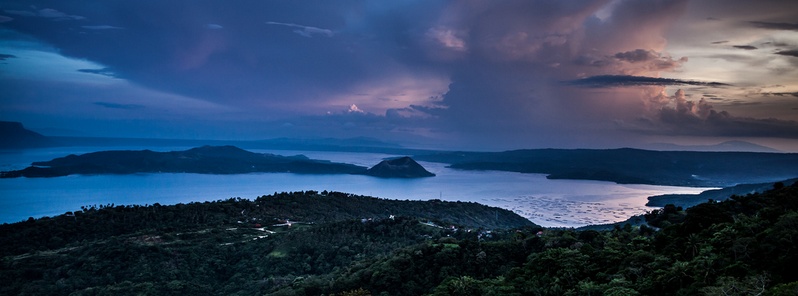Significant increase in seismicity detected at Taal volcano, Philippines

Taal volcano’s seismic network recorded 35 volcanic earthquakes during the past 24 hours, PHIVOLCS said in their bulletin issued 08:00 local time today. From February 3 to 4, they recorded a total of 39 earthquakes.
One of these earthquakes that occurred at 20:42 yesterday was reportedly felt at Intensity I in Barangay Calauit, Taal Volcano Island. Field measurements conducted on January 29, 2015 at the western sector of the Main Crater Lake recorded no change in water temperature of 29.5 °C, a decrease in water level from 0.86 to 0.82 meter, and a decrease in acidity from pH 3.08 to pH 3.10.
Ground deformation measurements through precise leveling surveys on November 19 – 30, 2014 indicated slight inflation of the edifice compared to June 2014.
Ground deformation measurements from GPS data also indicate an inflationary trend since May 2014, with the edifice being slightly inflated compared to February 2011 baseline data. Carbon dioxide (CO2) emission at the Main Crater Lake decreased from 2185 tonnes/day in November 2014 to 1980 tonnes/day in January 2015.
Alert Level 1 (on a scale of 0-5) remains in effect over Taal volcano which means that hazardous eruption is not imminent.
The public, however, is reminded that the Main Crater should be strictly off-limits because sudden steam explosions may occur and high concentrations of toxic gases may accumulate.
The northern portion of the Main Crater rim, in the vicinity of Daang Kastila Trail, may also become hazardous when steam emission along existing fissures suddenly increases.
Furthermore, the public is also reminded that the entire Volcano Island is a Permanent Danger Zone (PDZ), and permanent settlement in the island is strongly not recommended.
The last confirmed eruption of this volcano (VEI2) started on October 3, 1977 and ended around November 12, 1977.
Recent activity
Taal's last episode of increased seismicity, according to available GVP data, started in January 2011.
From January 15 to 16 PHIVOLCS detected 10 volcanic earthquakes; two earthquakes were felt by residents in Barangay (neighborhood) Pira-piraso, on the N side of the island. On January 17, three volcanic earthquakes were detected and on January 18, only one was reported. The Alert Level remained at 1.
Field observations January 18, 2011 revealed steam rising from the thermal area inside the Main Crater. Temperature and acidity of the lake were at normal levels, and the color had not changed. During January 12 to 25, up to seven daily volcanic earthquakes were detected by the seismic network.
Field observations during January 23 to 25, 2011 revealed an increase in the number of steaming vents inside Main Crater and a drop in the lake level.
On April 9, 2011 PHIVOLCS noted that after March 31 the number of earthquakes gradually rose and the depths become more shallow (1-4 km). Steaming at the N and NE sides of the main crater occasionally intensified and was occasionally accompanied by hissing sounds. The Alert Level was raised to 2 because of increased seismicity and carbon dioxide emissions. PHIVOLCS warned tourists and residents to avoid Volcano Island. According to news articles, about 100 families had volunteered to evacuate; about 7 000 people remained.
During April 12 to 19, PHIVOLCS reported that between 6 and 21 daily volcanic earthquakes were detected at Taal, some of which were felt by nearby residents.
Field measurements conducted on May 24 at the E sector inside Taal's Main Crater Lake showed that the water temperature slightly increased from 32.5 to 32.8 degrees Celsius, the pH value became more slightly acidic decreasing from 2.83 to 2.67, and the water level increased by 4 cm. During May 25 to 29, between 6 and 10 daily volcanic earthquakes were detected by the seismic network.
In July 2011, PHIVOLCS reported that during the previous 11 weeks, since the Alert Level for Taal was raised to 2 on April 9, the number of earthquakes recorded daily gradually declined, hydrothermal activity abated, carbon dioxide gas emissions decreased, ground temperature and total magnetic field measurements in the main crater showed no significant changes, and deformation data showed no signs of increasing pressure.
On July 5 the Alert Level was lowered from 2 to 1.
Geologic summary
Taal volcano is one of the most active volcanoes in the Philippines and has produced some of its most powerful historical eruptions. In contrast to Mayon volcano, Taal is not topographically prominent, but its prehistorical eruptions have greatly changed the topography of SW Luzon. The 15 x 20 km Talisay (Taal) caldera is largely filled by Lake Taal, whose 267 sq km surface lies only 3 m above sea level.
The maximum depth of the lake is 160 m, and several eruptive centers lie submerged beneath the lake. The 5-km-wide Volcano Island in north-central Lake Taal is the location of all historical eruptions.
The island is a complex volcano composed of coalescing small stratovolcanoes, tuff rings, and scoria cones that has grown about 25% in area during historical time.
Powerful pyroclastic flows and surges from historical eruptions of Taal have caused many fatalities. (GVP)
Featured image: Taal volcano by Freedom II Andres (CC – Flickr)

Commenting rules and guidelines
We value the thoughts and opinions of our readers and welcome healthy discussions on our website. In order to maintain a respectful and positive community, we ask that all commenters follow these rules.